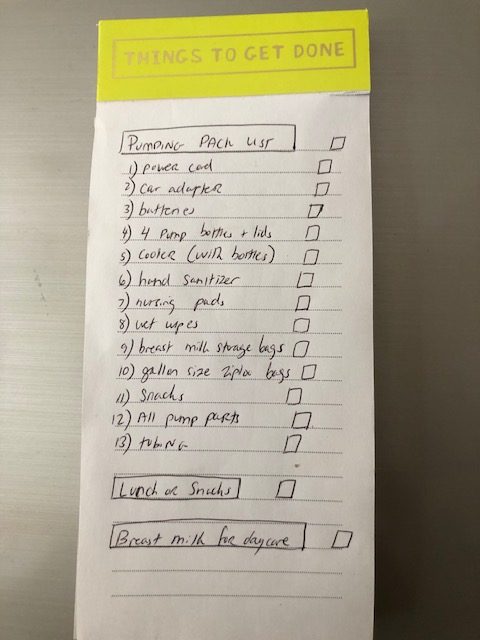I never took it down.
I have this notepad of my “Pumping Pack” list that I have kept on my refrigerator for over four years.
Part of me always wanted to remember what my life looked like when I was leaving at 7:00 a.m. with what seemed like 500 bags. My breast pump, lunch, snacks, laptop, and my five-foot-three-inch self bustled our way onto a commuter rail and squeezed in tight with three other people that also were commuting into Boston.
This was 2019. I was stressed, on fumes, and overwhelmed after maternity leave.
Sometimes, a mom would recognize the Sarah Wells pump bag and give me a look of affirmation. Other times, a commuter begrudgingly pushed over noticing that I had way too many bags—that don’t fit nicely in the seats.
Whatever that life was, I always wondered, “Is this really what moms do? They pack all this stuff and have to organize their day around pump sessions to feed their baby?”
It wasn’t our grandmothers’ pump bag. Grandmothers did not slug around a bag with a machine and parts. My grandmother was from Greece and she gave us Kit-Kats from her apron.
My mind was frazzled and stressed with this concept of the working mom with her pump bags.
Of course, I knew in my head that I was choosing to feed my baby through breast milk. I also couldn’t believe the magnitude of planning that moms around the country—and the world—did to make pumping work.
I wasn’t the only one.
I’ve heard how moms would transport breast milk while traveling on planes for work. Some pumped in closets for fifteen minutes because they were teaching and there was no place to go.
I just found the whole thing to be stressful and exhausting. I didn’t feel I was cut out for it.
But, I continued to do it.
When my second baby arrived, I decided that I wanted to pump again.
Only this time, my employer removed my “remote” days. I was going to be commuting into Boston five times a week with pump parts and bags. Also, I learned that the Mother’s Nursing room wasn’t in my building. So, I needed to return back to work, go to another building with all my bags, and stuff three times a day.
I had an hour and a half commute to and from work.
I made this choice of wanting to feed my baby this way, but I always felt like there was a better way.
So with this pandemic, I have to highlight that being remote for a working parent provides not only flexibility but comfort in the transition.
The working mother can pump three times per day in the comfort of her home (or kitchen), have access to meals, and be near conveniences without the stress of schlepping bags and wasting time running in between pump sessions.
I know this story may be a thing of the past or frankly obsolete someday. But what I will say is that this was always going on behind the scenes for working moms.
Whether we are breastfeeding, pumping, or formula feeding, we feed our babies while adjusting and doing the best we can—while running on fumes and the pressure of returning back to work before we’re ready.
What has to normalize is that mothers all over are on fumes trying to keep pace with the way modern-day parenting.
If it feels like it’s the Olympics, it’s because that’s what it is.
As a parent today, we feel like we’re trying to put together a logistical synchronized bobsled race just to get to work.
It’s not pretty.
The above picture is a slice of what the modern-day working woman.
Never mind having a full day prior to a workday at home and then an eight-plus-hour day—mothers return home to another shift afterward.
All of this never made a lot of sense to me.
A mother returns back to work just weeks or months after a year of creating and carrying a baby. We are still adjusting, healing, and learning the ropes. We arrive at the most vulnerable time of our lives with little to no education on breastfeeding.
Merely weeks later, the pump comes into play because maternity leave is over.
All this invisible logistical and stressful activity occurs to nurture and support a baby.
I think there’s a better way coming. One that has less movement all over the place and a more centered approach to living and working.
I know this story—it was my daily life in 2019 and nobody really knew the logistics but me.
It was isolating, exhausting, and challenging. It led to my own burnout.
But like other parents, we can’t just jump ship when things get hard.
There are finances involved and so many other pieces that keep women shackled to the norms while their mental health is on fumes.
Let’s strive to support working parents more by providing resources and an approach that helps them on their way.
As a young mom, I hope to not have to pass down my pump bag or its parts to my kids.
If they choose to have their own children, the pump, the bag, and its parts are not a legacy item. There’s a lot of stress in that machine. I know my grandmothers would have wanted me to find a better path—one less stressed and one with more Kit-Kats.
I hope my own daughters will find their way to motherhood with fewer bags and more joy.
~











Read 0 comments and reply